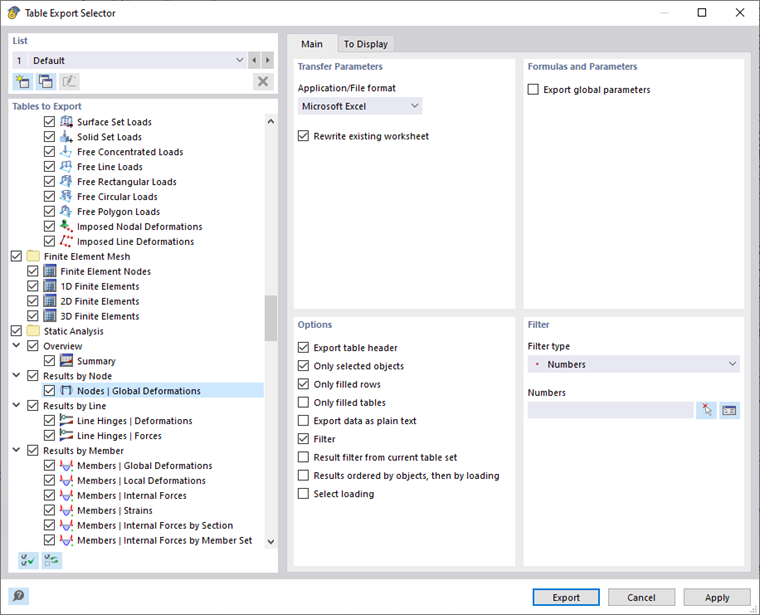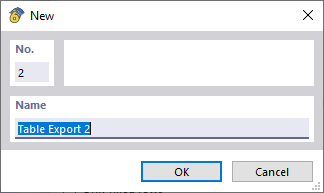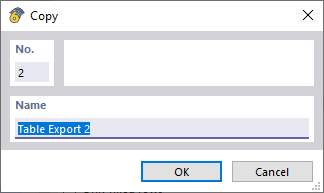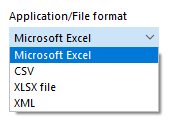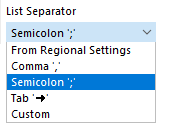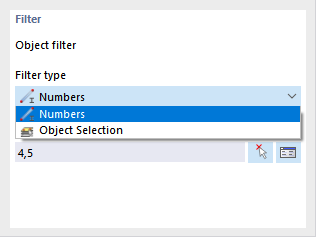The Table Export allows you to export all or selected RFEM tables with the results directly into an Excel table or as a CSV file.
List
You can import the export settings from a template or save them as a template.
To import the export settings from a template, select the template from the drop-down list. You can then make adjustments, if necessary.
To create a new template, use the
![]() button, then enter the template name. Enter the desired settings and click the "Apply" button to save them.
button, then enter the template name. Enter the desired settings and click the "Apply" button to save them.
Use the
![]() button to copy the template. Then, enter the template name. Enter the desired settings and click the "Apply" button to save them.
button to copy the template. Then, enter the template name. Enter the desired settings and click the "Apply" button to save them.
Use the
![]() button to rename a user-defined template, and the
button to rename a user-defined template, and the
![]() button to delete it.
button to delete it.
Tables to Export
The tables are listed in a directory tree. Select the tables that you want to export.
Transfer Parameters
Select the export format from the drop-down list.
Microsoft Excel
The tables are exported to an XML-based standard file format for Excel and the export file is opened in Microsoft Excel.
CSV
The tables are exported to a text file, organized in rows and columns. Rows are separated by a line break, and columns by a separator. You can specify the separator in the "Options".
XLSX
The tables are exported to an XML-based standard file format for Excel without opening Microsoft Excel.
Formulas and Parameters
Activate the "Export global parameters" option to export the global parameters, defined in the Global Parameters dialog box, as a separate table.
Options
Export table header
Specify whether to export the table header as well. If you don't select this check box, only the table content is exported.
Selected objects only
Use this check box to only export the data of the selected table rows. The selection is facilitated by the selection synchronization between the graphic and the table, which you can switch on and off using the buttons
![]() and
and
![]() in the table toolbar.
in the table toolbar.
Filled rows only
If you do not want to export any empty rows, select this check box.
Only filled tables
To export only the tables with data, select this check box.
Export data as plain text
To obtain all data as plain text, activate this check box.
Further options are available for exporting result tables:
Filter
Select this check box if you want to include only certain objects in the documentation.
Result filters from current table set
Usually, RFEM uses the same parameters for results as for the tables. If you clear the check box that is selected by default, you can prepare the result rows and columns for the printout in the To Display tab according to user-defined criteria, which are independent of the filter criteria for tables (see the Result Table Manager ).
Results ordered by objects, then by loading
By default, results are listed by load cases, combinations, and design situations. If you select the check box, the output will follow the order of the individual object numbers – for example, the results of load cases 1 through 5 for member 1, then the results of these load cases for member 2, etc.
Select loading
Select the check box if you only want to include certain load cases, design situations, or combinations in the documentation. You can then specify the loading in the
Load Cases/Combinations
tab.
Filter
This section is displayed when selecting the "Filter" check box in the "Options" dialog box section. Here, you can define the objects with properties or results relevant to you. Then, specify the criterion in the "Filter Type" list by which the objects should be filtered.
